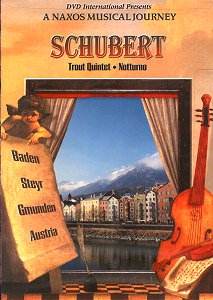I must say straight away that I expected great things
from this DVD. I have been an admirer of the Naxos project for many
years now and felt that they have made one of the most significant contributions
to recording history. The Trout Quintet is one of my favourite
chamber works - having discovered it as a teenager and loved it ever
since. Furthermore I believe that Austria has great natural beauty and
is saturated with musical history. So it came as a surprise to discover
that the DVD is mediocre – at least the visual element. The recording
by Ensemble Villa Musica is excellent – I have no complaint here. The
bottom line is that I imagined that after watching this on the television,
I would be compelled to book a holiday in Austria straightaway and start
planning a musical pilgrimage to the wonderful places presented on film.
In reality, however, the photography could be summed up as pleasant;
it is most certainly not stunning or inspiring. Much of it seems to
be of everyday people walking about workaday streets doing errands.
A lot of the images could have been filmed in many other European countries.
Even the vineyards outside Vienna could have been the fruit farms of
Lanarkshire!
Anyway let’s have a few words about the Trout Quintet.
It is often useful to remind ourselves about the genesis and content
of a very familiar work. The Quintet in A major D.667 was composed
in 1819. It has the distinction of being one of the earliest piano quintets
to be written. However it is not for the traditional combination. Schubert
used Violin, Viola, Cello and Double Bass along with the piano. There
is no part for the second Violin. The work was called The Trout or
Die Forelle, as is well known, because the 4th movement
quotes the Schubert song of the same name. The work is full of sunshine
and it is not hard to see why. Schubert wrote this work during one of
the very few happy periods in his life. He was on a walking holiday
with his friend Johann Michael Vogl in Austria at that time and was
exploring the area around Steyr. He stayed at the house of Sylvester
Paumgartner for a number of weeks. His host had requested a chamber
work that could be given at his residence. Schubert had obliged and
had quickly composed the work. In fact he only wrote out the string
parts – he played the piano part from memory at its first residential
performance. The composer completed the work after his return to Vienna.
The quintet is in five movements as opposed to the
traditional four. These are 1.Allegro vivace. 2. Andante. 3. Presto.
4. Andantino and 5. Allegro Giusto. The first movement is the longest
and throughout this there is a riot of lovely tunes. The second movement
is more reflective. Schubert based the third and last movements on Austrian
folk dances. The fourth movement, of course, is a series of six variations
on Die Forelle.
The other work on this DVD is the Trio (or Adagio)
in Eb major D897 ‘Notturno.’ Schubert had written two considerable
works for piano trio: the Bb (D898) and the Eb (D.929), both being masterpieces.
In addition to this there were two smaller pieces – the Piano Trio
in one movement in Bb D28 and the present 'Notturno'. The
title was not originally given by the composer but was appended to the
work by the publisher, Diabelli. It is a lovely work that is a joy to
listen to. It deserves to be better known.
One point to ponder on this recording: it is strange
that the ensemble requires a ‘conductor.’ The names of the individual
players are not given.
As I mentioned above, the imagery given to these two
works is hardly designed to show off Austria at its best. I can see
what the camera operator was trying to do – he was attempting to create
a mood picture rather than a publicity film. Yet the film does seem
dull. Even the lovely town of Baden does not seem to be presented in
the best light. Many of the images concentrate on the architecture of
commonplace buildings. I did get a bit excited seeing shots of a quaint
narrow gauge steam locomotive and train following the banks of the River
Steyr. But perhaps mechanical signals will not appeal to all tastes.
To be fair, there are some nice shots of Alpine pasture and running
water.
The film appears to be quite old – just look at the
clothes the public are wearing – and this contention is borne out by
the fact the that the box states it has been ‘re-mastered’.
I do not believe this DVD to be a particularly good
fusion of sights and sounds. It needed just a little bit more pizzazz.
I really did hope to be phoning the travel agent up to inquire about
weekend breaks in Austria. Perhaps I will just go to North Wales instead
– they too have lots of narrow gauge trains-and lots of running water.
Great music that is not enhanced by the somewhat pedestrian
film. It would not encourage me to book a holiday in Austria.
John France

![]() A NAXOS MUSICAL JOURNEY
A NAXOS MUSICAL JOURNEY![]() Ensemble Villa Musica/Leonard
Hokanson, conductor.
Ensemble Villa Musica/Leonard
Hokanson, conductor. ![]() NAXOS DVDI 1026 [50.00]
NAXOS DVDI 1026 [50.00]